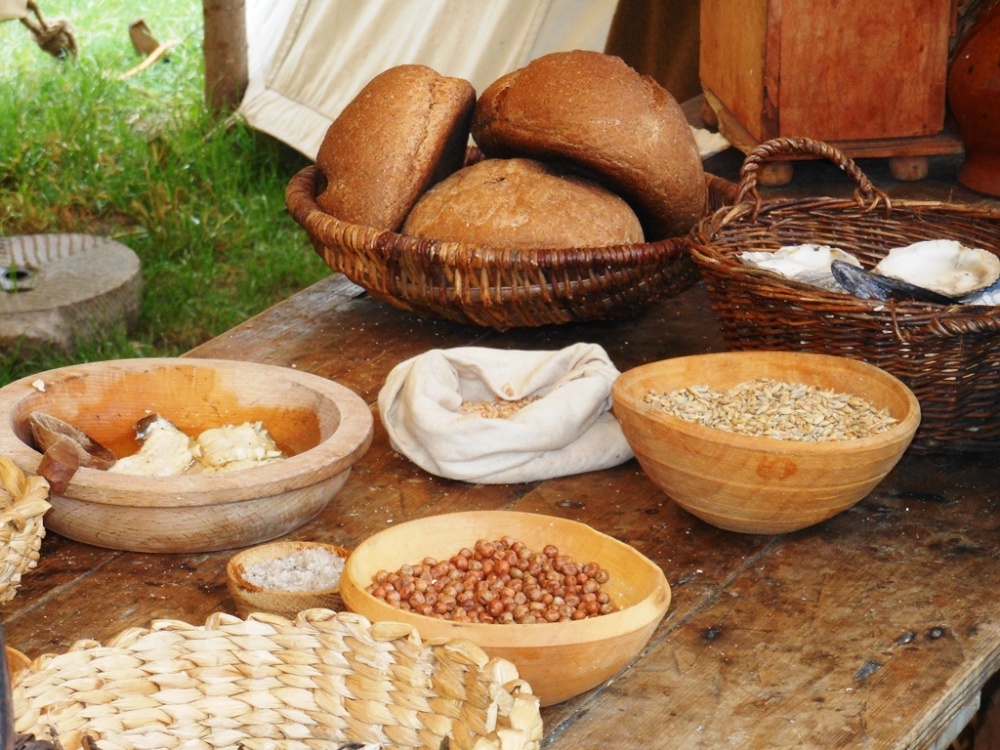

But, in fact, their diet was probably fresher and more vitamin-rich than ours.

We tend to believe that just because they didn't have electricity for refrigerators their food had be rotten. What did cost more was animal protein, spices, and sugar. Also if we compare our current wages to the cost of restaurant meals, we'll see that it still takes one or two hours of work today, just as it did then. Since so much food was raised in gardens, gathered in the woods, and raised on the farm, we can assume that at least half each the daily calories were not recorded this way. On further inspection we see that most accounts of period food costs don't include foods not taxed or sold. That doesn't leave much for anything else and should make a person skeptical. So imagine half your money going to food. Most history books will say that it took over 2 hours of an average worker's wage to pay for an average meal. They had to get every bit of nutrition out of an animal because raising animals for food was so expensive. They ate the glands, brain, heart, lungs, liver, kidneys, marrow, tongue, and even the eyes! They also ate the whole animal, not just the muscles and fat as we do now. The open-air food markets in every town were filled with a huge variety of fresh and saltwater fish, live wild birds, fresh eggs of every kind of fowl, wild game, freshly slaughtered beef, pork, kid, veal, mutton, lamb, and horse. They also foraged for mushrooms, berries, nuts, and other foodstuffs in the woodlands. Historically, farmers grew a wide variety of grains, vegetables, and fruits in their fields and gardens. So you would get the impression that we have more variety, but the truth is our variety has been whittled down to the main crops and domesticated animals that our food companies find most profitable. They also couldn't eat fruits and vegetables out of season the way that we can. In the Medieval period, Europeans didn't have New World foods like avocados, peppers, potatoes, tomatoes, maize, and many varieties of squash and beans that we now enjoy. Fresh or dried fruit, perhaps with a piece of cheese, was a common lunch. The word lunch meant snack-something that could be eaten while walking or working-for quick energy. Those who worked in the fields either took food with them or someone brought it out to them when it was ready. Breakfast, as a separate meal, was a later concept. Most people ate two meals a day, dinner at midday, and supper, in the evening. They might consult with their cooks from time to time, but for the most part, the cooks made all the decisions for the entire household and everyone ate what was served. So diet and health were inextricably linked even then.Įxcept on feast days, the wealthy dined with family and close friends in their private dining rooms. That gave rise to a trade in cookbooks all of which had large sections on what foods could be served to the sick.
#Medieval food professional#
Professional cooks who worked in castles or large manors had to be able to read and write so they could keep track of the large quantities of food they bought. Household specialists worked very hard to provide tasty meals that were healthy and nutritious. They either ate with their family, or if they were employed, they ate with the other servants in the great hall. In period, most people couldn't cook, nor did they need to know how. With all this decision-making comes responsibility to make good decisions, but we are so bombarded with advertisements encouraging us to make bad ones, it is hard to make the right decision every time. We need to choose what to eat and when, how much, whether to heat it or not, where to eat, how much to spend, etc. From the moment we wake, we have to decide whether to eat or not every moment, since food is always at hand.

We have to make hundreds, even thousands of food decisions everyday. One of the biggest differences is that now, once we are adults, we are responsible for our own food choices rather than having our food prepared for us by someone else everyday. It also made me think about all the misconceptions surrounding Medieval cuisine that have been printed in school books. Recently, I saw a documentary about food that got me thinking about the similarities and differences between dining in the Middle Ages and how we eat now.


 0 kommentar(er)
0 kommentar(er)
